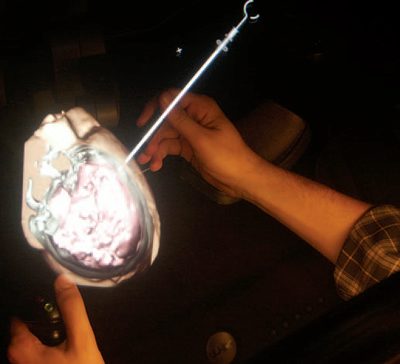Virtual Reality in Neurosurgical Education: Part-task Ventriculostomy Simulation with Dynamic Visual and Haptic Feedback
July 1st, 2007
Categories: Applications, Devices, Industrial VR, MS / PhD Thesis, Software, Tele-Immersion, Virtual Medicine, VR

Authors
Lemole, M. G., Banerjee, P. P., Luciano, C., Neckrysh, S., Charbel, F.T.About
OBJECTIVE: Mastery of the neurosurgical skill set involves many hours of supervised intraoperative training. Convergence of political, economic, and social forces has limited neurosurgical resident operative exposure. There is need to develop realistic neurosurgical simulations that reproduce the operative experience, unrestricted by time and patient safety constraints. Computer-based, virtual reality platforms offer just such a possibility. The combination of virtual reality with dynamic, three-dimensional stereoscopic visualization, and haptic feedback technologies makes realistic procedural simulation possible. Most neurosurgical procedures can be conceptualized and segmented into critical task components, which can be simulated independently or in conjunction with other modules to recreate the experience of a complex neurosurgical procedure.
METHODS: We use the ImmersiveTouch (ImmersiveTouch, Inc., Chicago, IL) virtual reality platform, developed at the University of Illinois at Chicago, to simulate the task of ventriculostomy catheter placement as a proof-of-concept. Computed tomographic data are used to create a virtual anatomic volume.
RESULTS: Haptic feedback offers simulated resistance and relaxation with passage of a virtual three-dimensional ventriculostomy catheter through the brain parenchyma into the ventricle. A dynamic three-dimensional graphical interface renders changing visual perspective as the user’s head moves. The simulation platform was found to have realistic visual, tactile, and handling characteristics, as assessed by neurosurgical faculty, residents, and medical students.
CONCLUSION: We have developed a realistic, haptics-based virtual reality simulator for neurosurgical education. Our first module recreates a critical component of the ventriculostomy placement task. This approach to task simulation can be assembled in a modular manner to reproduce entire neurosurgical procedures.
Copyright © by the Congress of Neurological Surgeons
Resources
URL
Citation
Lemole, M. G., Banerjee, P. P., Luciano, C., Neckrysh, S., Charbel, F.T., Virtual Reality in Neurosurgical Education: Part-task Ventriculostomy Simulation with Dynamic Visual and Haptic Feedback, Neurosurgery, vol 61, no 1, Lippincott Williams & Wilkins, pp. 142-149, July 1st, 2007. http://www.neurosurgery-online.com/pt/re/neurosurg/abstract.00006123-200707000-00016.htm;jsessionid=HqQp3FGnThKBQknV9yvGFcPLyHPN9lCFLrR2Gyx7PhBph14ynLGN!-194